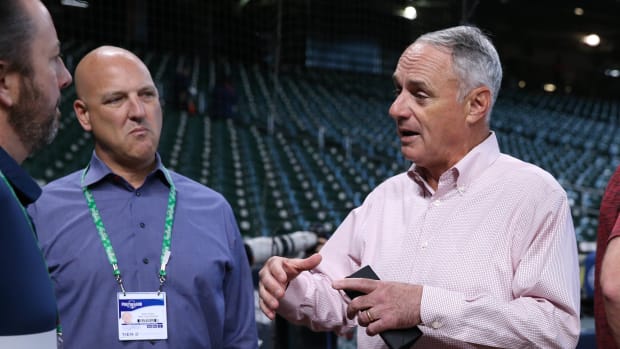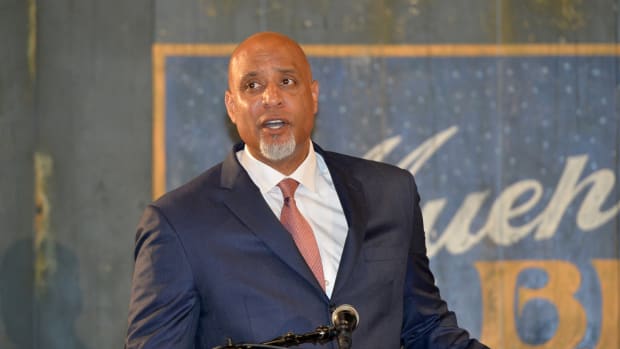Source: MLB, MLBPA Gaining Momentum, But Significant Hurdles Remain in CBA Talks
Major League Baseball (MLB) and the MLB Players Association (MLBPA) met Tuesday at the bargaining table for a second straight day. While the two sides did not make a deal, like Monday's meeting, progress toward a new Collective Bargaining Agreement was made.
One source with knowledge of the CBA negotiations told InsideTheRangers.com that the league's proposal focused on better compensation for younger players, specifically pre-arbitration players. In addition, one day after the union made two major concessions, including earlier free agency, the league's proposal included two significant concessions of their own.
MLB withdrew their proposal to replace the salary arbitration process in favor of a formula-based model. This would keep the previous system—including Super Two eligibility—intact. MLB also agreed to the MLBPA's offer of a bonus pool for qualifying pre-arbitration players.

While both sides have made concessions and found more common ground in the past two days, there is still a ways to go before a new deal is agreed upon.
Tuesday's proposal from the league also included a salary minimum of $615,000, up from the $600,000 previously offered. MLB also maintained all other aspects of its previous proposal for a tiered minimum salary system. First-year players would make $615,000, second-year players would earn $650,000 and third-year players would make $700,000. All three figures would increase throughout the length of the agreement at set amounts. However, as in previous proposals from the league, the salary minimums would be fixed, eliminating the possibility for any player to earn more than their respective minimum.
Per source, a bump of $15,000 and any restrictions to players potentially earning more than the minimum was not viewed kindly by the union. By contrast, the union's previous proposal would set the minimum at $775,000 for all players, growing to $875,000 by the end of the agreement, and would not limit the flexibility for a player to possibly earn more than the minimum salary.
Regarding the pre-arbitration bonus pool, the two sides may agree to the concept, but are very far apart in dollars. The union initially offered a pool of $105 million. The league countered with $10 million, which, according to a source on the players' side, is "not even close" to what is needed for an agreement on the issue.
In addition to the work that needs to be done on the league minimum and the pre-arbitration bonus pool, perhaps the biggest hurdle left in the negotiations is the Competitive Balance Tax (CBT, or luxury tax). One source emphasized the union was serious and clear about wanting to see the league focus on the CBT "before anything else". Yet, Tuesday's proposals from MLB did not address the CBT, its threshold or the penalties for those who exceed it.
In Monday's meeting, the MLBPA proposed a significant bump of the CBT threshold from $210 million to $245 million. MLB's most recent proposal regarding the CBT threshold was a meager increase to $214 million. The two sides also differ on the harshness of penalties for those who exceed the threshold. Players want fewer, less severe penalties so clubs are more incentivized to spend money. The league wants harsher penalties to lessen the gap between those at the top and bottom.

In addition, the league remained steadfast on making zero changes to the revenue sharing model, per source. MLB commissioner Rob Manfred has fervently spoken out against any changes to the revenue sharing mechanism. MLB Network's Jon Heyman reported a management source predicts the MLBPA will eventually give this up in trade.
One final sliver of optimism from the two meetings, per source, is both sides agreed to meet more frequently. MLB and the MLBPA will meet again "in the coming days", but only to discuss non-core issues, including the Joint Drug Agreement, grievances and scheduling. Meanwhile, the union plans to reconvene with player reps to discuss the next steps regarding core economics.
The common ground is growing—slowly but surely—and both sides have softened their stances on some critical issues. More consistent dialogue provides some optimism that the end of the lockout is coming sooner rather than later. However, with each day that passes, a shortened spring training becomes more and more likely. The two sides still have breathing room to strike an agreement in enough time to salvage Opening Day. That said, the calendar is still applying quite a bit of pressure, which may explain the recent concessions made by both sides.
Make sure to like SI's 'Inside The Rangers' on Facebook
